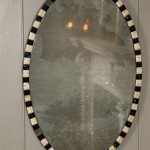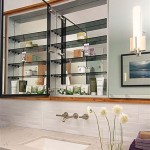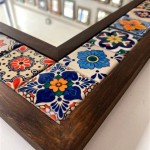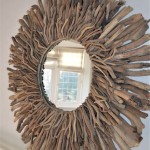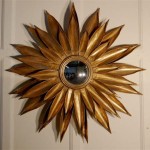How to Make a Mirror Frame From Wood
Adding a custom-made wooden frame to a mirror can instantly enhance its aesthetic appeal and personalize its look. Creating a mirror frame from wood is a rewarding DIY project that allows you to showcase your creativity and woodworking skills. This article outlines the steps involved in constructing a sturdy and beautiful mirror frame from wood, providing a comprehensive guide for beginners and seasoned woodworkers alike.
1. Planning and Preparation
Before embarking on the project, meticulous planning is crucial. This involves gathering the necessary materials, determining the desired dimensions for the frame, and selecting an appropriate wood type. Here's a breakdown of the essential steps:
a. Measure and Determine Frame Dimensions
Start by measuring the mirror's dimensions accurately. To calculate the frame's dimensions, consider the desired width of the frame. For instance, a 2-inch frame width added to each side of a 20-inch by 30-inch mirror will result in a frame size of 24 inches by 34 inches. Mark these dimensions on the wood using a pencil and ruler. Remember to account for the thickness of the wood when calculating the overall frame size.
b. Choose Wood Type
The selection of wood type depends on personal preference, desired style, and budget. Some popular options include:
- Pine: Affordable, softwood with a natural grain pattern. Easy to work with but prone to scratches.
- Oak: Durable, hardwood with a distinctive grain pattern. Strong and resistant to scratches.
- Cherry: Hardwood known for its warm, reddish-brown color. Adds elegance and sophistication.
- Walnut: Hardwood with rich, dark brown color and beautiful grain patterns. Prized for its durability and beauty.
c. Gather Tools and Materials
Assemble the required tools and materials before starting the project. Essential items include:
- Woodworking clamps: For securing wood pieces during assembly.
- Wood glue: For bonding the frame pieces.
- Miter saw or table saw: For precise cuts. A miter saw allows for angled cuts, ideal for creating mitered corners.
- Sandpaper (various grits): For smoothing surfaces and removing imperfections.
- Finishing nails or screws: For securing the frame pieces together.
- Wood stain or paint (optional): To enhance the frame's appearance.
- Protective finish (optional): For sealing and protecting the wood, such as polyurethane or varnish.
2. Cutting and Assembling the Frame
With the materials and tools ready, proceed to cut and assemble the frame pieces. Adhering to the dimensions determined in the planning phase is crucial for achieving a well-proportioned frame.
a. Cut Wood Pieces
Using a miter saw or table saw, carefully cut the wood into four pieces corresponding to the frame dimensions. Ensure precise and clean cuts for a professional finish. If using a miter saw, set the angle to 45 degrees to create mitered corners, which provide a seamless appearance. For a simple frame, straight cuts at 90 degrees can be used.
b. Join Frame Pieces
Apply a thin layer of wood glue to the edges of the frame pieces that will be joined. Align the pieces carefully, ensuring the corners are flush and the frame is square. Secure the pieces together using woodworking clamps. Allow the glue to dry completely before proceeding, following the manufacturer's instructions.
c. Attach the Mirror
Once the frame is assembled, attach the mirror to the back of the frame. This can be done by using mirror clips, which are metal brackets designed to securely hold the mirror in place. Alternatively, you could use a mirror adhesive, ensuring it is strong enough to support the mirror's weight. If using adhesive, be sure to follow the manufacturer's instructions carefully to ensure a secure and lasting bond.
3. Finishing Touches
After the frame is assembled and the mirror is attached, the final touches involve sanding, staining or painting, and applying a protective finish to enhance the frame's beauty and durability.
a. Sanding the Frame
Sand the frame using sandpaper of various grits to smooth any rough edges and create a uniform surface. Start with a coarser grit and progressively move to finer grits to achieve a fine finish. Sand all surfaces of the frame, including the inside edges. Be careful not to sand the mirror itself.
b. Staining or Painting the Frame
Optional: To enhance the wood's natural grain pattern and color, apply a wood stain. Choose a stain color that complements the mirror and the surrounding décor. Follow the manufacturer's instructions for applying and drying the stain. Alternatively, paint the frame with a color that matches your desired style and aesthetic. Apply multiple thin coats of paint for a smooth and even finish.
c. Applying a Protective Finish
Optional: Applying a protective finish, such as polyurethane or varnish, will help seal the wood and protect it from moisture, scratches, and UV damage. This step is especially important if the mirror is placed in a high-traffic area or a humid environment. Follow the manufacturer's instructions for application, drying time, and multiple coats.

Diy Farmhouse Wood Frame Mirror She Gave It A Go

Wood Mirror Diy Shanty 2 Chic

Diy Framed Mirror Jaime Costiglio

How To Make A Simple Mirror Frame With Wood Upgrade An Old

Diy Wood Framed Bathroom Mirror Christina Maria Blog

Framed Floor Mirror Love Grows Wild

How To Make A Wood Mirror Frame

How To Build A Mirror Frame Simple Woodworking

How To Build A Mirror Frame Sunshine And Rainy Days

Diy Reclaimed Wood Frames The Space Between

